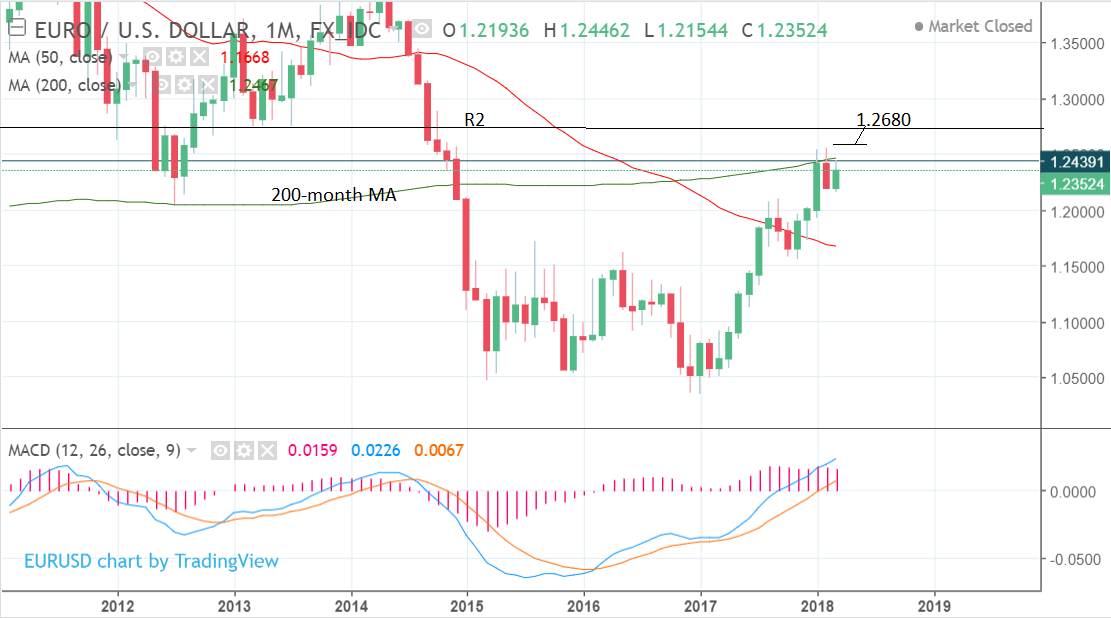The Euro-to-Dollar Rate's Forecast Over the Next Five Days
- EUR/USD is still stuck in a sideways range within a broader uptrend
- Upside is capped by resistance from the 200-month MA
- Inflation data will be the next key release in the future, though this week is quiet

© Grecaud Paul, Adobe Stock
The Euro-to-Dollar rate continues to trade sideways at the start of the new week with no real change to our analysis and conclusions from the previous week.
EUR/USD is in a longer-term uptrend which started at the January 2017 lows and topped at 1.2556 last month (February).
This uptrend is still intact despite the recent broadly sideways activity and our forecast, therefore, remains broadly bullish over the longer-term time horizon.
This sideways-orientated range will probably continue to unfold in the short-term but eventually breakout higher in line with the broader trend.
The problem for Euro bulls is that the 200-month moving average (MA), which is situated at the range highs and is resisting upside (see above).
Large moving averages act as formidable obstacles on charts because many investors use them as their primary decision-making tool and this increases selling pressure around them.
Sometimes wholesale reversals occur at the level of MAs but at the moment we don't see this happening at the 200-month MA.
The pull-back is probably only temporary - notice how a similar pull-back occurred when the pair touched the 50-month MA (red line) back in August 2017 but then continued up.
A break above 1.2575 would provide bullish confirmation of a full clearance of the MA and probably see the exchange rate rise up to a target at 1.2680 just below the R2 monthly pivot - another barrier to further upside.
Pivots are calculated using the open, high, close, and low of the previous month and provide traders which a short-hand reference for gauging the trend. They are also levels of support and resistance in themselves which attract a lot of short-term selling from traders looking to ride the volatility around them.
Get up to 5% more foreign exchange by using a specialist provider to get closer to the real market rate and avoid the gaping spreads charged by your bank when providing currency. Learn more here.
Data and Events to Watch for the US Dollar
The Euro showed vulnerability last week after manufacturing and services data for March showed a continued slowdown and it is against this backdrop of slowing growth than the currency will be assessed in the coming week.
The next major set of releases for the Euro is inflation out the week after next, with only Germany inflation out in the week ahead, on Thursday at 13.00 GMT.
German inflation is not expected to be representative of inflation dynamics in the rest of the Eurozone, however, so it may have limited impact, according to analysts at Nordea Bank.
"We caution against reading too much into German inflation figures out next Thursday as the Easter effect could distort the picture - this month to the upside," says Nordea's chief analyst Martin Enlund et al.
Eurozone loan growth and money supply for February, meanwhile, are out on Tuesday, March 27, at 9.00. The former is forecast to rise by 3.0% from 2.9% in January and the later to remain at 4.6% - the same as the previous month.
Loan growth and money supply are important for the Euro as the indicate credit dynamics and more take up or availability of credit is usually a positive sign for the economy, and therefore the Euro.
A whole load of sentiment indicators is scheduled for release at 10.00 on Tuesday, including the final estimate for consumer confidence in March, industrial, services and economic sentiment in March and business confidence also for March.
Data and Events to Watch for the Dollar
Data releases are likely to be in short supply in the week ahead, with the main events confined to the Q4 GDP second estimate on Wednesday at 13.30 GMT, and Personal Consumption Expenditure (PCE) which is the Federal Reserve's (Fed) favoured metric for measuring inflation out on the day after at the same time.
The Fed sets interest rates in the US and since interest rates are the main driver for currencies because they attract foreign capital inflows, PCE, could impact on the US Dollar, with an upside result boosting the Dollar and vice-versa for a downside result.
"The US PCE Price Index is gaining momentum (see chart) combined with last week's Dollar weakness and the tight labour market, we see risks tilted towards a higher reading than the consensus estimate 0.2% mom reading," says Nordea bank's chief strategist Martin Enlund et al.
As far as Q4 GDP goes, it's not often the second estimate shows much of a change from the flash and first estimate, but economists are still forecasting a slight upwards revision to 2.6% from 2.5% previously, on an annualized basis, which means compared to Q4 in 2017.
Concerns about a trade war erupting after the US imposed heavy tariffs on imports, especially those from China, could dampen the global growth outlook if they escalate, however, this is likely to lead to upside in the Dollar since one of its main headwinds is RoW - which is short for growth in the 'Rest of the World', which is seen eclipsing US growth and attracting investors away from the US by more lucrative opportunities elsewhere.
Get up to 5% more foreign exchange by using a specialist provider to get closer to the real market rate and avoid the gaping spreads charged by your bank when providing currency. Learn more here.











